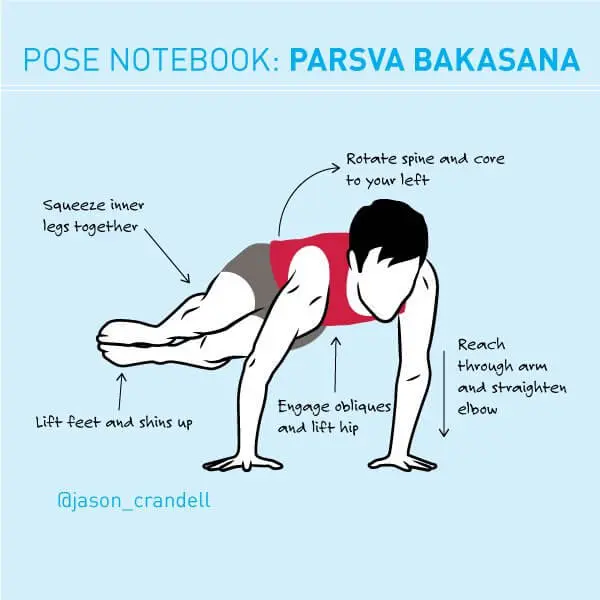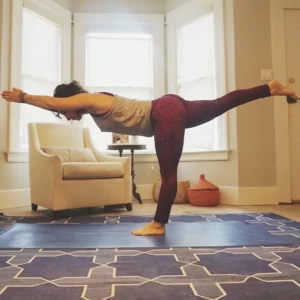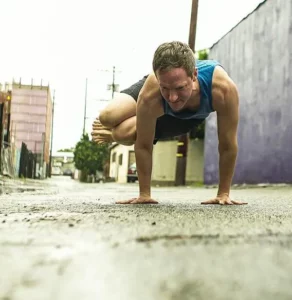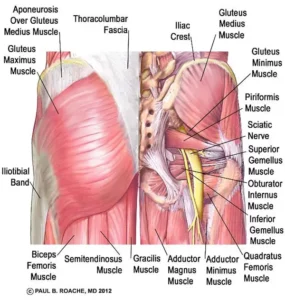Parsva Bakasana (Side Crow Pose) is a part of the iconic Bakasana family of arm balances. I frequently include the posture in my classes and I break it down for my students this way: I demonstrate how the posture is one part twist, one part squat, and one part Chaturanga. Is it simple? Yes. Is it easy? No. Especially the version illustrated in the infographic above, where the outer hip hovers above elbow instead of resting on it. Still, it’s a good bang-for-your-buck kinda of pose since you’re strengthening your upper body and core, as well as generating greater spinal flexibility at the same time.
If you struggle with Parsva Bakasana, you’re not the only one. There’s a big ‘ole club of practitioners that remain baffled by the combination of actions that create the pose. I was once part of the club. Hang in there and practice. If the pose is accessible for you, spend time refining its nuances and building up your duration in the pose. Remember, this is the foundational twisting arm balance, which means gaining depth and proficiency in this pose will help you with more demanding twisting arm balances down the road.
WARM UP
Since Parsva Bakasana (Side Crow) includes a deep twist, it’s a good idea to do a few outer hip openers and simple twists before you practice this pose. Outer hip openers like Gomukhasana and Pigeon Pose will help your spine rotate more easily. Simple twists like Reclined Twist and Ardha Matseyendrasana I will help warm up your spine and make the twisting component of Parsva Bakasana more accessible. Postures that connect you to your core, like Navasana and Ardha Navasana will help wake up your center and prepare you for this arm balance.
HOW TO DO PARSVA BAKASANA (SIDE CROW)
The initial set-up for Side Crow is a little odd. And, reading instructions for twisting postures can be challenging, so hang in there. The pose is worth it.
1. Stand at the top of your mat with your feet together. Turn your entire body, including your feet, to face the right front corner of your mat.
2. Bend your knees deeply and lower down into a squat. Your whole body will be still be diagonal and facing the corner of your mat.
3. Rotate your upper body to face the front of your mat and lower your right arm down the outside of your left knee. Place both hands on your mat facing the front edge of the mat. Keep both hands in line with each other.
4. Pause and take a breath. You’ve already done two-thirds of the pose—the squat and the twist. Now, you just have to get yourself into Chaturanga from here!
5. Now it’s time to lift off. Begin by lifting your hips a couple of inches. Your hips should be slightly higher then your elbows. Bend your elbows and lower your chest like you’re moving your upper-body into Chaturanga.
7. As you bend your elbows and lower your chest, your feet will become lighter and lighter. Your body is moving like an old-fashioned scale. As the weight of your body moves forward into your hands, your feet will become weightless.
8. Now that you’re able to lift your feet off the floor, focus on doing the actions in the infographic above!
9. Take 3-5 breaths in the pose before lower your feet and repeating on the posture on the other side.
IF I CAN’T DO PARSVA BAKASANA YET, WHAT SHOULD I DO INSTEAD?
Side Crow can be tricky. Sometimes students don’t need more strength or flexibility to do the pose—they just need more practice figuring out how to make the transition into the posture correctly. So, be mindful that you may just need to try and try again. That said, if you’re still struggling with the pose, practice opening your outer hips, deepening your twists, strengthening your core, and strengthening your upper body. Practicing Navasana and refining your Chaturanga are two immmediate postures that you can do in order to build up to this posture.
PART II: ANATOMY AND SEQUENCING FOR PARSVA BAKASANA
WHICH MUSCLES DOES PARSVA BAKASANA STRENGTHEN?
As you read the following, keep in mind that Bakasana and Parsva Bakasana strengthen similar muscle groups. Working on any posture in the Bakasana family will help you access the other ones.
Your abdominals and pelvic floor
All of your abdominal and pelvic floor muscles are working intensely. Your transversus abdominis and rectus abdominis are working to flex the spine and keep your center lifted in the pose. Your obliques are working with your spinal muscles (more below) to rotate your spine in the twist.
Your spinal muscles
Your erector spinae, rotators, and multifidi are working with your obliques to help lift and rotate your spine.
Your hip flexors
Your hip flexors, especially your psoas and illiacus, are working to flex your hip and help keep your knees elevated on your arms.
Your inner legs
You adductors are engaging to keep both of your legs together.
Your shoulders
Like Bakasana, Your shoulders play a huge role in Bakasana. Your rotator cuff group is working to stabilize the position of your upper arms in their socket; your deltoids are working to support the weight of your body; your serratus anterior is working to broaden your scapula; and, your pecs are working to support the weight of your body.
Your arms
Your triceps have one of the biggest jobs keeping you afloat in Side Crow. They work against the weight of gravity, which is pushing you toward the floor. And they work to straighten your arms if you’re working on the most advanced version of the pose.
WHICH MUSCLES DOES PARSVA BAKASANA STRETCH?
Your spinal muscles
Your abdominals and spinal muscles get a mild stretch in Parsva Bakasana. You’ll also receive a stretch in the same muscles that you’re strengthening—but on the opposite side!
Your outer hips
If your outer hips are restricted, the twisting action of this pose will create a mild stretch in your abductor group.
SEQUENCING FOR PARSVA BAKASANA
You can find a fully-illustrated, 16-pose sequence for Parsva Bakasana (Side Crow) here.
{illustration by MCKIBILLO}



